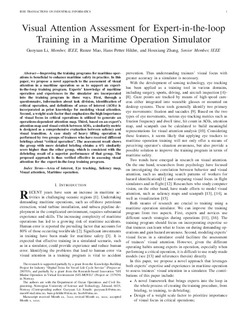| dc.contributor.author | Li, Guoyuan | |
| dc.contributor.author | Mao, Runze | |
| dc.contributor.author | Hildre, Hans Petter | |
| dc.contributor.author | Zhang, Houxiang | |
| dc.date.accessioned | 2019-10-16T07:11:58Z | |
| dc.date.available | 2019-10-16T07:11:58Z | |
| dc.date.created | 2019-10-15T10:45:37Z | |
| dc.date.issued | 2019 | |
| dc.identifier.issn | 1551-3203 | |
| dc.identifier.uri | http://hdl.handle.net/11250/2622421 | |
| dc.description.abstract | Improving the training programs for maritime operations is beneficial to enhance maritime safety in practice. In this paper, we propose a novel approach to the assessment of visual attention in a maritime operation so as to support an expert-in-the-loop training program. Experts' knowledge of maritime operation and experiences in the simulator are incorporated into the training program in three ways. First, through a questionnaire, information about task division, identification of critical operation, and definitions of areas of interest (AOIs) is incorporated as prior knowledge for modeling visual attention. Second, a weight scale factor that emphasizes the high importance of visual focus in critical operations is utilized to generate an operations-dependent attention map. Third, based on an expert's attention map and visual switch between AOIs, a similarity metric is designed as a comprehensive evaluation between saliency and visual transition. A case study of heavy lifting operation is performed by two groups of trainees who have received different briefings about “critical operation”. The assessment result shows the group with more detailed briefing obtains a 6% similarity score higher than the other group, which is consistent with the debriefing result of a superior performance of that group. The proposed approach is thus verified effective in assessing visual attention for the expert-in-the-loop training program. | nb_NO |
| dc.language.iso | eng | nb_NO |
| dc.publisher | IEEE | nb_NO |
| dc.title | Visual Attention Assessment for Expert-in-the-loop Training in a Maritime Operation Simulator | nb_NO |
| dc.type | Journal article | nb_NO |
| dc.type | Peer reviewed | nb_NO |
| dc.description.version | acceptedVersion | nb_NO |
| dc.source.journal | IEEE Transactions on Industrial Informatics | nb_NO |
| dc.identifier.doi | 10.1109/TII.2019.2945361 | |
| dc.identifier.cristin | 1737125 | |
| dc.relation.project | Norges forskningsråd: 280703 | nb_NO |
| dc.relation.project | Norges forskningsråd: 237929 | nb_NO |
| dc.description.localcode | © 2019 IEEE. Personal use of this material is permitted. Permission from IEEE must be obtained for all other uses, in any current or future media, including reprinting/republishing this material for advertising or promotional purposes, creating new collective works, for resale or redistribution to servers or lists, or reuse of any copyrighted component of this work in other works. | nb_NO |
| cristin.unitcode | 194,64,93,0 | |
| cristin.unitname | Institutt for havromsoperasjoner og byggteknikk | |
| cristin.ispublished | false | |
| cristin.fulltext | postprint | |
| cristin.qualitycode | 2 | |
